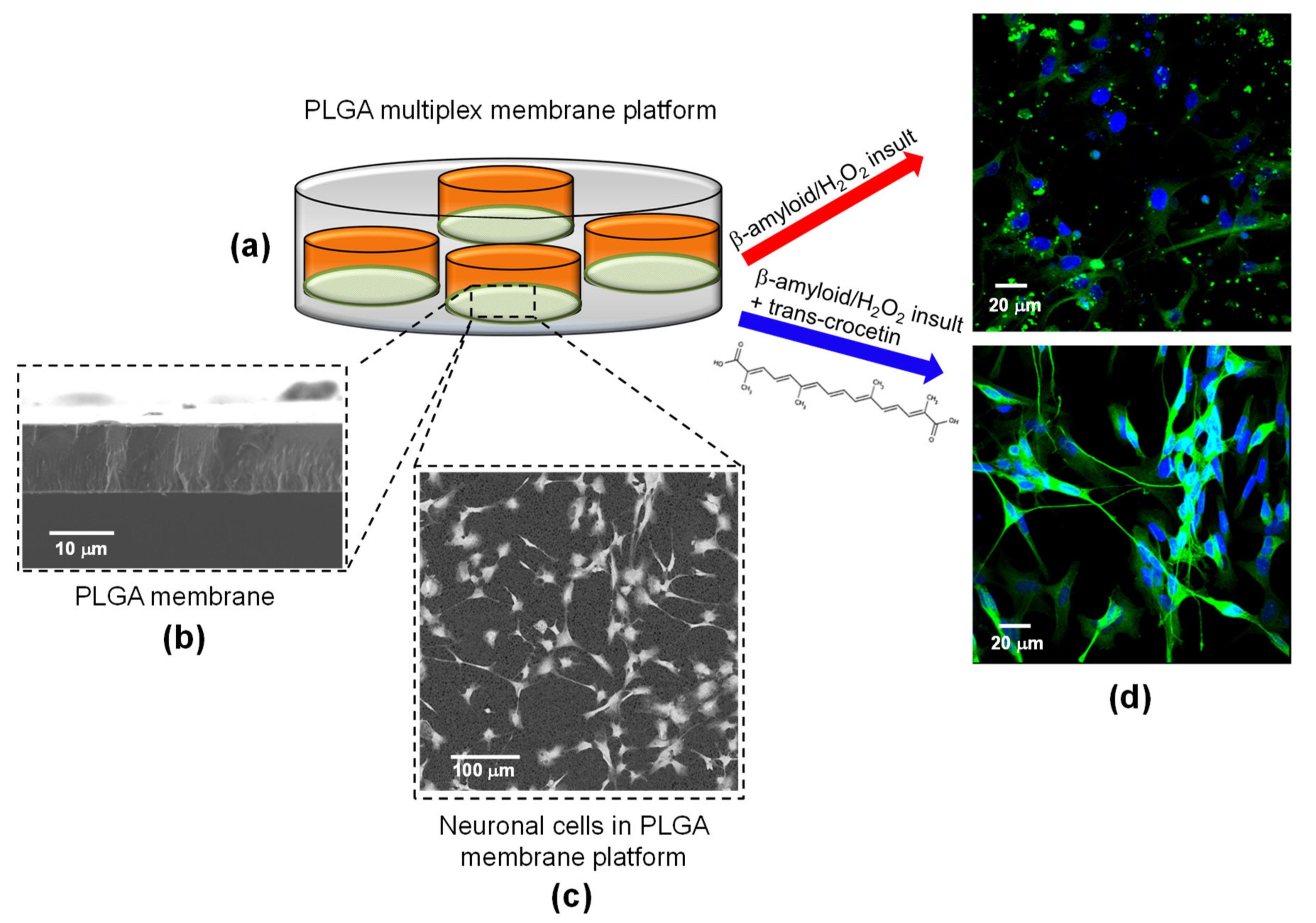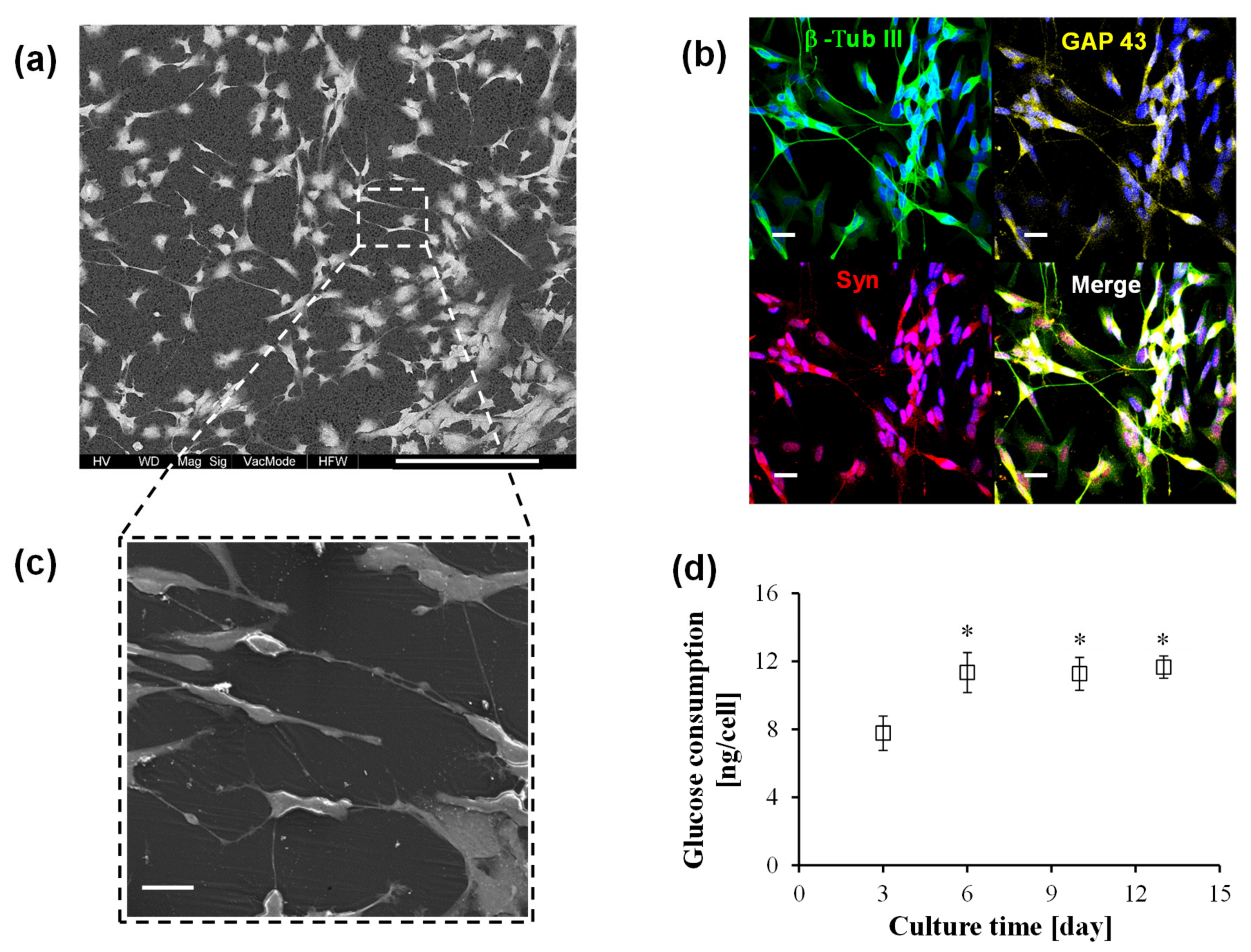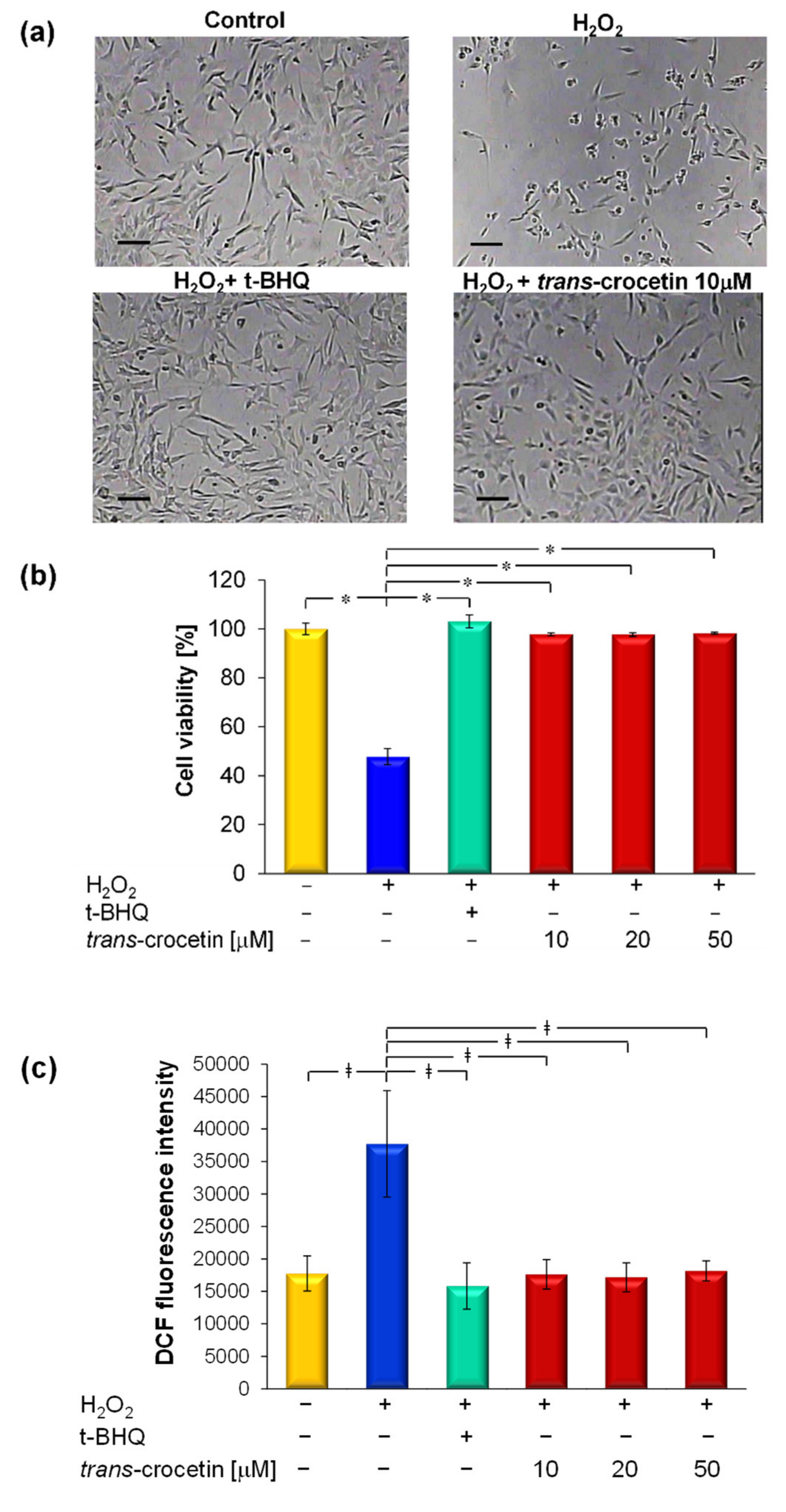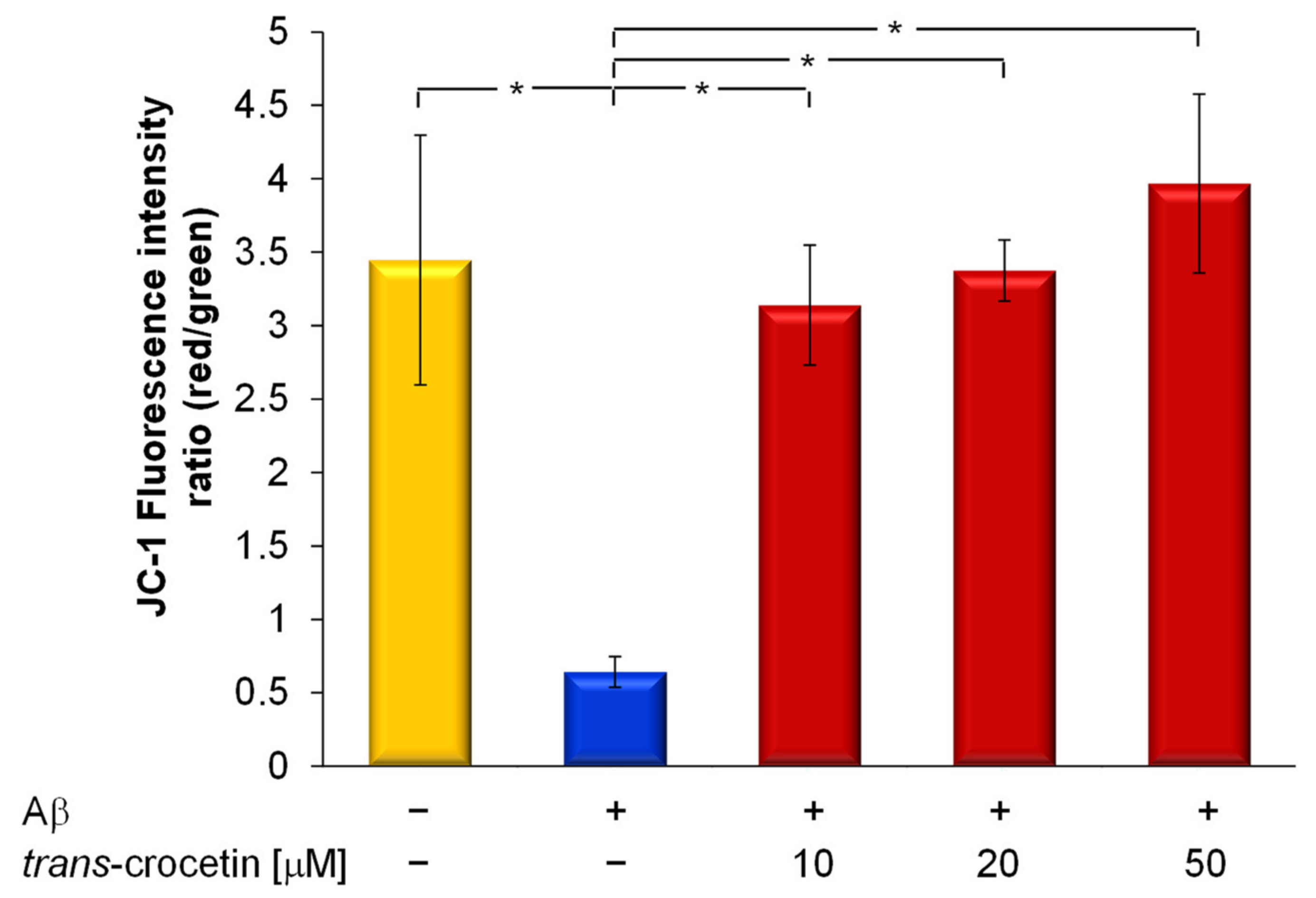PLGA Multiplex Membrane Platform for Disease Modelling and Testing of Therapeutic Compounds
Abstract
1. Introduction
2. Materials and Methods
2.1. Membrane System
2.1.1. Preparation of PLGA Membranes
2.1.2. Characterization of PLGA Membranes
2.2. Cell Culture
2.3. Evaluation of Neuronal Differentiation
2.3.1. SEM Analysis
2.3.2. Immunostaining for Confocal Analysis
2.3.3. Metabolic Function
2.4. Cell Treatments: Oxidative Stress, β-Amyloid Toxicity and Trans-Crocetin Administration
2.5. Evaluation of Trans-Crocetin Anti-Oxidant Effect
2.5.1. Cell Viability
2.5.2. ROS Production
2.6. Detection of Trans-Crocetin Anti-β-Amyloid-Induced Toxicity
Apoptosis Detection
2.7. Statistical Analysis
3. Results and Discussion
3.1. Characterization of PLGA Membrane Properties
3.2. PLGA Multiplex Membrane Platform Enables Neuronal Growth and Differantiation
3.3. PLGA Multiplex Membrane System Allows Multiple Simultaneous Investigation
3.3.1. Anti-Oxidative Effect of Trans-Crocetin by Means of Membrane Platform
3.3.2. Anti-Amyloidogenic Effect of Trans-Crocetin by Means of Membrane Platform
4. Conclusions
Author Contributions
Funding
Institutional Review Board Statement
Informed Consent Statement
Data Availability Statement
Conflicts of Interest
References
- Mantecón-Oria, M.; Diban, N.; Berciano, M.T.; Rivero, M.J.; David, O.C.; Lafarga, M.; Tapia, O.; Urtiaga, A. Hollow Fiber Membranes of PCL and PCL/Graphene as Scaffolds with Potential to Develop in vitro Blood–Brain Barrier Models. Membranes 2020, 10, 161. [Google Scholar] [CrossRef]
- Nikolakopoulou, P.; Rauti, R.; Voulgaris, D.; Shlomy, I.; Maoz, B.M.; Herland, A. Recent progress in translational engineered in vitro models of the central nervous system. Brain 2020, 143, 3181–3213. [Google Scholar] [CrossRef] [PubMed]
- Jorfi, M.; D’Avanzo, C.; Kim, D.Y.; Irimia, D. Three-Dimensional Models of the Human Brain Development and Diseases. Adv. Healtc. Mater. 2018, 7. [Google Scholar] [CrossRef]
- Park, J.; Wetzel, I.; Marriott, I.; Dréau, D.; D’Avanzo, C.; Kim, D.Y.; Tanzi, R.E.; Cho, H. A 3D human triculture system modeling neurodegeneration and neuroinflammation in Alzheimer’s disease. Nat. Neurosci. 2018, 21, 941–951. [Google Scholar] [CrossRef]
- Piscioneri, A.; Morelli, S.; Mele, M.; Canonaco, M.; Bilotta, E.; Pantano, P.; Drioli, E.; De Bartolo, L. Neuroprotective effect of human mesenchymal stem cells in a compartmentalized neuronal membrane system. Acta Biomater. 2015, 24, 297–308. [Google Scholar] [CrossRef]
- Morelli, S.; Salerno, S.; Piscioneri, A.; Tasselli, F.; Drioli, E.; De Bartolo, L. Neuronal membrane bioreactor as a tool for testing crocin neuroprotective effect in Alzheimer’s disease. Chem. Eng. J. 2016, 305, 69–78. [Google Scholar] [CrossRef]
- Morelli, S.; Piscioneri, A.; Salerno, S.; Chen, C.-C.; Chew, C.H.; Giorno, L.; Drioli, E.; De Bartolo, L. Microtube array membrane bioreactor promotes neuronal differentiation and orientation. Biofabrication 2017, 9, 025018. [Google Scholar] [CrossRef] [PubMed]
- Morelli, S.; Piscioneri, A.; Curcio, E.; Salerno, S.; Chen, C.-C.; De Bartolo, L. Membrane bioreactor for investigation of neurodegeneration. Mater. Sci. Eng. C 2019, 103, 109793. [Google Scholar] [CrossRef]
- Morelli, S.; Piscioneri, A.; Guarnieri, G.; Morelli, A.; Drioli, E.; De Bartolo, L. Anti-neuroinflammatory effect of daidzein in human hypothalamic GnRH neurons in an in vitro membrane-based model. BioFactors 2020. [Google Scholar] [CrossRef] [PubMed]
- Pasman, T.; Baptista, D.; Van Riet, S.; Truckenmüller, R.; Hiemstra, P.; Rottier, R.J.; Stamatialis, D.; Poot, A.A. Development of Porous and Flexible PTMC Membranes for In Vitro Organ Models Fabricated by Evaporation-Induced Phase Separation. Membranes 2020, 10, 330. [Google Scholar] [CrossRef]
- Peng, S.-W.; Li, C.-W.; Chiu, I.-M.; Wang, G.-J. Nerve guidance conduit with a hybrid structure of a PLGA microfibrous bundle wrapped in a micro/nanostructured membrane. Int. J. Nanomed. 2017, 12, 421–432. [Google Scholar] [CrossRef] [PubMed][Green Version]
- Morelli, S.; Piscioneri, A.; Salerno, S.; Rende, M.; Campana, C.; Tasselli, F.; Di Vito, A.; Giusi, G.; Canonaco, M.; Drioli, E.; et al. Flat and tubular membrane systems for the reconstruction of hippocampal neuronal network. J. Tissue Eng. Regen. Med. 2011, 6, 299–313. [Google Scholar] [CrossRef]
- Morelli, S.; Piscioneri, A.; Messina, A.; Salerno, S.; Drioli, E.; De Bartolo, L.; Al-Fageeh, M.B. Neuronal growth and differentiation on biodegradable membranes. J. Tissue Eng. Regen. Med. 2012, 9, 106–117. [Google Scholar] [CrossRef]
- Qian, X.; Song, H.; Ming, G.-L. Brain organoids: Advances, applications and challenges. Development 2019, 146, dev166074. [Google Scholar] [CrossRef]
- Morelli, S.; Piscioneri, A.; Drioli, E.; De Bartolo, L. Neuronal Differentiation Modulated by Polymeric Membrane Properties. Cells Tissues Organs 2017, 204, 164–178. [Google Scholar] [CrossRef]
- Zhang, J.; Wang, Y.; Dong, X.; Liu, J. Crocetin attenuates inflammation and amyloid-β accumulation in APPsw transgenic mice. Immun. Ageing 2018, 15, 1–8. [Google Scholar] [CrossRef]
- Wong, K.H.; Xie, Y.; Huang, X.; Kadota, K.; Yao, X.-S.; Yu, Y.; Chen, X.; Lu, A.; Yang, Z. Delivering Crocetin across the Blood-Brain Barrier by Using γ-Cyclodextrin to Treat Alzheimer’s Disease. Sci. Rep. 2020, 10, 1–12. [Google Scholar] [CrossRef]
- Yamauchi, M.; Tsuruma, K.; Imai, S.; Nakanishi, T.; Umigai, N.; Shimazawa, M.; Hara, H. Crocetin prevents retinal degeneration induced by oxidative and endoplasmic reticulum stresses via inhibition of caspase activity. Eur. J. Pharmacol. 2011, 650, 110–119. [Google Scholar] [CrossRef]
- Chalatsa, I.; Arvanitis, D.A.; Koulakiotis, N.S.; Giagini, A.; Skaltsounis, A.L.; Papadopoulou-Daifoti, Z.; Tsarbopoulos, A.; Sanoudou, D. The Crocus sativus Compounds trans-Crocin 4 and trans-Crocetin Modulate the Amyloidogenic Pathway and Tau Misprocessing in Alzheimer Disease Neuronal Cell Culture Models. Front. Neurosci. 2019, 13, 249. [Google Scholar] [CrossRef] [PubMed]
- Bacakova, L.; Filova, E.; Parizek, M.; Ruml, T.; Svorcik, V. Modulation of cell adhesion, proliferation and differentiation on materials designed for body implants. Biotechnol. Adv. 2011, 29, 739–767. [Google Scholar] [CrossRef] [PubMed]
- Barnes, J.M.; Przybyla, L.; Weaver, V.M. Tissue mechanics regulate brain development, homeostasis and disease. J. Cell Sci. 2017, 130, 71–82. [Google Scholar] [CrossRef]
- Hopkins, A.M.; DeSimone, E.; Chwalek, K.; Kaplan, D.L. 3D in vitro modeling of the central nervous system. Prog. Neurobiol. 2015, 125, 1–25. [Google Scholar] [CrossRef]
- Hatziagapiou, K.; Kakouri, E.; Lambrou, G.I.; Bethanis, K.; Tarantilis, P.A. Antioxidant Properties of Crocus Sativus L. and Its Constituents and Relevance to Neurodegenerative Diseases; Focus on Alzheimer’s and Parkinson’s Disease. Curr. Neuropharmacol. 2019, 17, 377–402. [Google Scholar] [CrossRef]
- Giaccio, M. Crocetin from Saffron: An Active Component of an Ancient Spice. Crit. Rev. Food Sci. Nutr. 2004, 44, 155–172. [Google Scholar] [CrossRef]
- Hashemi, M.; Hosseinzadeh, H. A comprehensive review on biological activities and toxicology of crocetin. Food Chem. Toxicol. 2019, 130, 44–60. [Google Scholar] [CrossRef]
- Wang, C.; Cai, X.; Hu, W.; Li, Z.; Kong, F.; Chen, X.; Wang, D. Investigation of the neuroprotective effects of crocin via antioxidant activities in HT22 cells and in mice with Alzheimer’s disease. Int. J. Mol. Med. 2019, 43, 956–966. [Google Scholar]
- Hara, H.; Ohta, M.; Ohta, K.; Kuno, S.; Adachi, T. Increase of antioxidative potential by tert-butylhydroquinone protects against cell death associated with 6-hydroxydopamine-induced oxidative stress in neuroblastoma SH-SY5Y cells. Brain Res. Mol. Brain Res. 2003, 119, 125–131. [Google Scholar] [CrossRef] [PubMed]
- Papandreou, M.A.; Tsachaki, M.; Efthimiopoulos, S.; Cordopatis, P.; Lamari, F.N.; Margarity, M. Memory enhancing effects of saffron in aged mice are correlated with antioxidant protection. Behav. Brain Res. 2011, 219, 197–204. [Google Scholar] [CrossRef]
- Kong, Y.; Kong, L.P.; Luo, T.; Li, G.W.; Jiang, W.; Li, S.; Zhou, Y.; Wang, H.Q. The protective effects of crocetin on aβ1–42-induced toxicity in Ht22 cells. CNS Neurol. Disord. Dr. 2014, 13, 1627–1632. [Google Scholar] [CrossRef] [PubMed]
- Prokhorova, E.A.; Kopeina, G.S.; Lavrik, I.N.; Zhivotovsky, B. Apoptosis regulation by subcellular relocation of caspases. Sci. Rep. 2018, 8, 1–11. [Google Scholar] [CrossRef] [PubMed]
- Shaulov-Rotem, Y.; Merquiol, E.; Weiss-Sadan, T.; Moshel, O.; Salpeter, S.; Shabat, D.; Kaschani, F.; Kaiser, M.; Blum, G. A novel quenched fluoresce.ent activity-based probe reveals caspase-3 activity in the endoplasmic reticulum during apoptosis. Chem. Sci. 2016, 7, 1322–1337. [Google Scholar] [CrossRef] [PubMed]
- Ordoudi, S.; Befani, C.D.; Nenadis, N.; Koliakos, G.G.; Tsimidou, M.Z. Further Examination of Antiradical Properties of Crocus sativus Stigmas Extract Rich in Crocins. J. Agric. Food Chem. 2009, 57, 3080–3086. [Google Scholar] [CrossRef] [PubMed]
- Lautenschläger, M.; Sendker, J.; Hüwel, S.; Galla, H.; Brandt, S.; Düfer, M.; Riehemann, K.; Hensel, A. Intestinal formation of trans-crocetin from saffron extract (Crocus sativus L.) and in vitro permeation through intestinal and blood brain barrier. Phytomedicine 2015, 22, 36–44. [Google Scholar] [CrossRef] [PubMed]





| PLGA Membrane | |
|---|---|
| Thickness [μm] | 14 ± 2 |
| Mean Pore Diameter [nm] | 16 ± 2 |
| WCA [°] | θadv 89 ± 4 θrec 55 ± 2 |
| E [N/mm2] | 293± 76 |
| ε [%] | 397 ± 40 |
| UTS [N/mm2] | 15 ± 31 |
Publisher’s Note: MDPI stays neutral with regard to jurisdictional claims in published maps and institutional affiliations. |
© 2021 by the authors. Licensee MDPI, Basel, Switzerland. This article is an open access article distributed under the terms and conditions of the Creative Commons Attribution (CC BY) license (http://creativecommons.org/licenses/by/4.0/).
Share and Cite
Piscioneri, A.; Morelli, S.; Drioli, E.; De Bartolo, L. PLGA Multiplex Membrane Platform for Disease Modelling and Testing of Therapeutic Compounds. Membranes 2021, 11, 112. https://doi.org/10.3390/membranes11020112
Piscioneri A, Morelli S, Drioli E, De Bartolo L. PLGA Multiplex Membrane Platform for Disease Modelling and Testing of Therapeutic Compounds. Membranes. 2021; 11(2):112. https://doi.org/10.3390/membranes11020112
Chicago/Turabian StylePiscioneri, Antonella, Sabrina Morelli, Enrico Drioli, and Loredana De Bartolo. 2021. "PLGA Multiplex Membrane Platform for Disease Modelling and Testing of Therapeutic Compounds" Membranes 11, no. 2: 112. https://doi.org/10.3390/membranes11020112
APA StylePiscioneri, A., Morelli, S., Drioli, E., & De Bartolo, L. (2021). PLGA Multiplex Membrane Platform for Disease Modelling and Testing of Therapeutic Compounds. Membranes, 11(2), 112. https://doi.org/10.3390/membranes11020112









